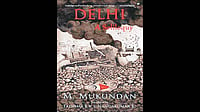Shahryar’s recitations at mushairas bore a trademark nonchalance. A languid drawl. No high notes. No shrill excesses. Much like his poetry, that spoke to you like an intimate friend, yet touched the soul. It is this timeless quality of his poetry that Rakshanda Jalil brings out deftly in her book Shahryar: A Life in Poetry. It unravels the essence of his poetic vision, which was “to speak of the world, to the world”.
Born as Kunwar Akhlaq Muhammed Khan, he took Shahryar as a nom de plume in his later years. It was deemed that Shahryar would join the police force like his father and elder brother. But the rich cultural life in the Aligarh Muslim University of the 1950s and the active encouragement of friends and mentors ensured that Shahryar found his calling as a poet and academic.
Shahryar was a man not bound by isms. Though a self-confessed Marxist, he was not an atheist. He was influenced by the radically opposed schools of thought—the progressivists and the modernists—but he was never one of them. According to Jalil, Shahryar’s seminal contribution to modern Urdu literature was to marry the traditional and contemporary idiom together and infuse the ghazal with a new rang (colour) and ahang (melody). And, as Gulzar observed, he also bridged the distance between the ghazal and nazm, the shorter and younger form of Urdu poetry.
The book explores many facets of Shahryar’s poetic vision—the recurring motifs of dream, sleep and thirst in his poems, his felicity with words and his concerns with the relationship between men and women, and sexuality that is neither overt nor coy. Jalil refuses to dwell too much on Shahryar’s personal life and wrench out reasons for the dislocation and melancholy in some of his poetry, terming it unfair to his creative process. She also believes Shahryar’s limited oeuvre in film lyricism does not define his poetry.
His movie songs have remained timeless, like the unsettling Seene mein jalan and Ajeeb saneha from the movie Gaman, reflecting the cold impassivity of urban life, or the haunting melodies of Umrao Jaan. But Jalil believes the general obsession with his film songs do disservice to a Jnanpith awardee who produced six highly regarded volumes of poetry and two editions of collected works. Nevertheless, they underline Shahryar’s masterful brevity in conveying emotions. He also refrained from using izaafat, or coining new expressions using hyphenated words. His poetry is bereft of extreme views or agenda-driven polemics, yet they convey a disquiet that speaks louder than the most fiery rhetoric: Tumhare shahr mein kuchh bhi huwa nahin hai kya/Ke tumne cheekhon ko sachmuch suna nahin hai kya (Has nothing happened in this city of yours?/ Have you really not heard the screams?)
If at all there was any ambiguity in his poems, there was none in Shahryar’s position on the Art vs Life debate. He had said, “If such a situation arises where I am forced to choose between life and art, I will choose life. Poetry is nothing more than this for me.”
As scholar Gopi Chand Narang summed it up, “Shahryar’s urge was inner and his own.”
























